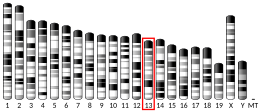Chemokine (C-C motif) ligand 28 (CCL28), also known as mucosae-associated epithelial chemokine (MEC), CCK1 and SCYA28, is a chemokine. CCL28 regulates the chemotaxis of cells that express the chemokine receptors CCR3 and CCR10. CCL28 is expressed by columnar epithelial cells in the gut, lung, breast and the salivary glands and drives the mucosal homing of T and B lymphocytes that express CCR10, and the migration of eosinophils expressing CCR3.[5][6][7] This chemokine is constitutively expressed in the colon, but its levels can be increased by pro-inflammatory cytokines and certain bacterial products implying a role in effector cell recruitment to sites of epithelial injury.[8] CCL28 has also been implicated in the migration of IgA-expressing cells to the mammary gland,[9] salivary gland, intestine[10] and other mucosal tissues.[11] It has also been shown as a potential antimicrobial agent effective against certain pathogens, such as Gram negative and Gram positive bacteria and the fungus Candida albicans.[8]
Human CCL28 is encoded by an RNA transcript of 373 nucleotides and a gene with four exons. The gene codes for a 127-amino acid CCL28 protein with a 22-amino acid N-terminal signal peptide. It shares 76% nucleic acid identity and 83% amino acid similarity to the equivalent molecule in mouse.[12][13] Sequence analysis has revealed CCL28 to be most similar to another CC chemokine called CCL27.
Gene neighbourhood
editThe gene C5orf34 is found downstream of CCL28 and is a predicted to be in the Polo-like Kinase family. C5orf34 extends from base pair 43,486,701 to base pair 43,515,445.[14]
References
edit- ^ a b c GRCh38: Ensembl release 89: ENSG00000151882 – Ensembl, May 2017
- ^ a b c GRCm38: Ensembl release 89: ENSMUSG00000074715 – Ensembl, May 2017
- ^ "Human PubMed Reference:". National Center for Biotechnology Information, U.S. National Library of Medicine.
- ^ "Mouse PubMed Reference:". National Center for Biotechnology Information, U.S. National Library of Medicine.
- ^ Rodriguez MW, Paquet AC, Yang YH, Erle DJ (July 2004). "Differential gene expression by integrin beta 7+ and beta 7- memory T helper cells". BMC Immunology. 5: 13. doi:10.1186/1471-2172-5-13. PMC 476736. PMID 15236665.
- ^ Kunkel EJ, Kim CH, Lazarus NH, Vierra MA, Soler D, Bowman EP, Butcher EC (April 2003). "CCR10 expression is a common feature of circulating and mucosal epithelial tissue IgA Ab-secreting cells". The Journal of Clinical Investigation. 111 (7): 1001–10. doi:10.1172/JCI17244. PMC 152588. PMID 12671049.
- ^ John AE, Thomas MS, Berlin AA, Lukacs NW (February 2005). "Temporal production of CCL28 corresponds to eosinophil accumulation and airway hyperreactivity in allergic airway inflammation". The American Journal of Pathology. 166 (2): 345–53. doi:10.1016/S0002-9440(10)62258-4. PMC 1602329. PMID 15681819.
- ^ a b Hieshima K, Ohtani H, Shibano M, Izawa D, Nakayama T, Kawasaki Y, Shiba F, Shiota M, Katou F, Saito T, Yoshie O (February 2003). "CCL28 has dual roles in mucosal immunity as a chemokine with broad-spectrum antimicrobial activity". Journal of Immunology. 170 (3): 1452–61. doi:10.4049/jimmunol.170.3.1452. PMID 12538707.
- ^ Wilson E, Butcher EC (September 2004). "CCL28 controls immunoglobulin (Ig)A plasma cell accumulation in the lactating mammary gland and IgA antibody transfer to the neonate". The Journal of Experimental Medicine. 200 (6): 805–9. doi:10.1084/jem.20041069. PMC 2211970. PMID 15381732.
- ^ Feng N, Jaimes MC, Lazarus NH, Monak D, Zhang C, Butcher EC, Greenberg HB (May 2006). "Redundant role of chemokines CCL25/TECK and CCL28/MEC in IgA+ plasmablast recruitment to the intestinal lamina propria after rotavirus infection". Journal of Immunology. 176 (10): 5749–59. doi:10.4049/jimmunol.176.10.5749. PMID 16670280.
- ^ Lazarus NH, Kunkel EJ, Johnston B, Wilson E, Youngman KR, Butcher EC (April 2003). "A common mucosal chemokine (mucosae-associated epithelial chemokine/CCL28) selectively attracts IgA plasmablasts". Journal of Immunology. 170 (7): 3799–805. doi:10.4049/jimmunol.170.7.3799. PMID 12646646.
- ^ Wang W, Soto H, Oldham ER, Buchanan ME, Homey B, Catron D, Jenkins N, Copeland NG, Gilbert DJ, Nguyen N, Abrams J, Kershenovich D, Smith K, McClanahan T, Vicari AP, Zlotnik A (July 2000). "Identification of a novel chemokine (CCL28), which binds CCR10 (GPR2)". The Journal of Biological Chemistry. 275 (29): 22313–23. doi:10.1074/jbc.M001461200. PMID 10781587.
- ^ Pan J, Kunkel EJ, Gosslar U, Lazarus N, Langdon P, Broadwell K, Vierra MA, Genovese MC, Butcher EC, Soler D (September 2000). "A novel chemokine ligand for CCR10 and CCR3 expressed by epithelial cells in mucosal tissues". Journal of Immunology. 165 (6): 2943–9. doi:10.4049/jimmunol.165.6.2943. PMID 10975800.
- ^ "CCL28 C-C motif chemokine ligand 28 [Homo sapiens (human)]". Gene – NCBI.



